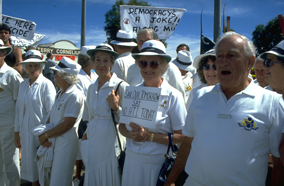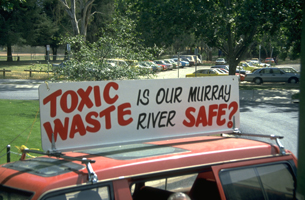 Public relations firms often classify local residents, as they do environmentalists, into various publics so that they can concentrate on those likely to be persuaded of the benefits of the proposed project and marginalising those who are likely to oppose it. Desmond Connor a Canadian PR consultant advises against holding a public meeting early on before the various publics can be approached separately. He says:
Public relations firms often classify local residents, as they do environmentalists, into various publics so that they can concentrate on those likely to be persuaded of the benefits of the proposed project and marginalising those who are likely to oppose it. Desmond Connor a Canadian PR consultant advises against holding a public meeting early on before the various publics can be approached separately. He says:
The proponent typically calls a public meeting in order to explain the project to them, confident that their opposition will then disappear. In fact, the public meeting usually crystallizes a more informed, organized and articulate opposition and generates widespread negative publicity for the proponent and the project.
Instead he advises companies to identify “the latent and secondary beneficiaries of the project (the five volt positive people, compared with the 220 volt negative opponents).” These are people who “stand to benefit in small and indirect ways” from the project. These people should be kept informed and involved in a “joint problem solving process. As people work together, informed peer group pressure usually results in workable compromise solutions - not ideal from anyone’s point of view, but acceptable to all or nearly all.”
 In 1989 an Australian Joint Taskforce on Intractable Waste engaged the public relations firm Community Projects Ltd to develop a community consultation strategy to prepare the way for the establishment of a high temperature incinerator in Australia to burn hazardous wastes. Several attempts had already been made to site an incinerator for hazardous wastes but none has been successful, usually because of the strength of local opposition to the facility.
In 1989 an Australian Joint Taskforce on Intractable Waste engaged the public relations firm Community Projects Ltd to develop a community consultation strategy to prepare the way for the establishment of a high temperature incinerator in Australia to burn hazardous wastes. Several attempts had already been made to site an incinerator for hazardous wastes but none has been successful, usually because of the strength of local opposition to the facility.
The Taskforce attempted, with the help of Community Projects Ltd, to get broad ‘in principle’ acceptance for the high temperature incinerator before a location for it was chosen. This was supposed to ensure a detached, 'rational' debate took place before the emotions of concerned local residents clouded the issue and before the community living near the proposed incinerator site could muster support from the broader community. Environmental groups were approached to procure their commitment to the project before they could be approached and influenced by a stricken community once the site was chosen. Some environmental groups supported the incinerator while others opposed it.
The consultation process did not seek to find out what the community wanted done with hazardous wastes. That was decided even before the Taskforce was appointed. It’s aim was to win acceptance for a high temperature incinerator. The Taskforce and their PR consultants sought to "achieve active public recognition that the proposal is in the public interest."
Dorothy Nelkin and Michael Pollak, found this was a typical approach after studying various technological controversies:
Mechanisms for public involvement may increase direct public influence on the formation of policy, or may merely inform policy makers about public concerns. More often they are a means to manipulate public opinion, to win acceptance of decisions already made, and to facilitate the implementation of these decisions.
The Taskforce, like others involved in such siting controversies, assumed that most opposition "is based upon ignorance that can  be overcome" if the appropriate information is supplied. It therefore supplied reassuring information to the groups whose support it sought. However, the most fervent opponents to the incinerator were among the best informed on the issue, a point the Taskforce admitted in one of its reports when it observed that supporters or potential supporters "tend to be less well-informed on the issues involved than are the opponents."
be overcome" if the appropriate information is supplied. It therefore supplied reassuring information to the groups whose support it sought. However, the most fervent opponents to the incinerator were among the best informed on the issue, a point the Taskforce admitted in one of its reports when it observed that supporters or potential supporters "tend to be less well-informed on the issues involved than are the opponents."
The Task Force was advised not to waste its persuasive efforts on that part of the environment movement opposed to the incinerator because they were unlikely to change their position. Community Projects interviewed opposition groups in order to distinguish "opposition likely to thwart a desired outcome ('effect') from that which is likely to be ineffective even if it is discomforting ('noise')." The reason for needing to do this was that the Taskforce wanted to manage and control the debate or, as it put it, "limit destructive conflict". It stated:
Unstructured public involvement is likely to be chaotic and potentially destructive to a proposal. In the absence of a structure for public involvement, individuals and groups will create their own mechanisms...
By providing a framework for public involvement, the form and direction of this involvement can be managed in the public interest. Under these circumstances public involvement in the development of a proposal is more likely to be productive and creative, and the scope for destructive conflict is significantly reduced...
Of course the terms ‘productive’ and ‘creative’ and ‘destructive’ are all defined in terms of achieving the goal of establishing a hazardous waste facility.
 Allies from within the environment movement were enlisted to help get the incinerator accepted in Australia. Remaining opponents were categorised and dismissed as either ignorant, having vested interests, or, in the case of those stubborn yet well informed, environmentalists who could not be co-opted, the Taskforce stated that they showed “clear signs of wishing to assume the role of champions". The use of the term ‘champions’ was a way of implying that opponents are not concerned about the public interest. The Taskforce stated:
Allies from within the environment movement were enlisted to help get the incinerator accepted in Australia. Remaining opponents were categorised and dismissed as either ignorant, having vested interests, or, in the case of those stubborn yet well informed, environmentalists who could not be co-opted, the Taskforce stated that they showed “clear signs of wishing to assume the role of champions". The use of the term ‘champions’ was a way of implying that opponents are not concerned about the public interest. The Taskforce stated:
Champions are those who see some benefits for themselves in adopting one position or another in a potential conflict. They are sometimes more concerned with the opportunity to enhance their reputation than with the details of the case.
The Taskforce was unsuccessful in its efforts and to date no hazardous waste incinerator has been established in Australia. Instead various parts of the waste stream are to be treated with more specific technologies, some currently being developed for the purpose.
Often a public consultation exercise is little more than a public relations exercise, undertaken for the primary purpose of winning public accceptance for an unwanted facility. The process of consultation provides an opportunity for the developer to show a caring, open approach and to cultivate trust in the face of community concerns. Yet more often than not corporations (and governments) are unwilling to reduce or eliminate the hazards that give rise to those concerns and their public relations advisers help them to mould and manage public opinion instead of responding to it.
Public relations shapes the interaction between corporations and their ‘publics’ in a way that is designed to mould public opinion and win acceptance of corporate goals and ideologies. Yet that influence only works while it is hidden. The exposure of public relations strategies and messages and their source undermines their strength and persuasive power.